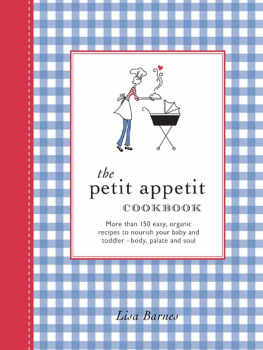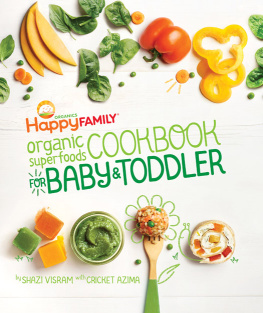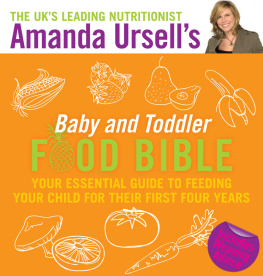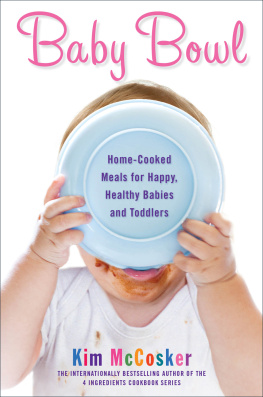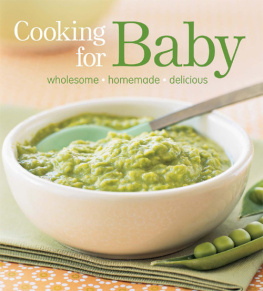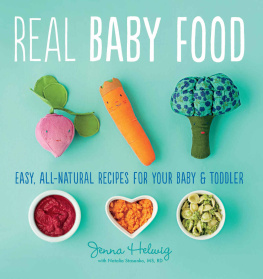the petit appetit COOKBOOK

Easy Organic Recipes to Nurture
Your Baby and Toddler

the petit appetit COOKBOOK
Easy Organic Recipes to Nurture
Your Baby and Toddler

LISA BARNES
HPBOOKS
THE BERKLEY PUBLISHING GROUP
Published by the Penguin Group
Penguin Group (USA) Inc.
375 Hudson Street, New York, New York 10014, USA
Penguin Group (Canada), 10 Alcorn Avenue, Toronto, Ontario M4V 3B2, Canada (a division of Pearson Penguin Canada Inc.)
Penguin Books Ltd., 80 Strand, London WC2R 0RL, England
Penguin Group Ireland, 25 St. Stephens Green, Dublin 2, Ireland (a division of Penguin Books Ltd.)
Penguin Group (Australia), 250 Camberwell Road, Camberwell, Victoria 3124, Australia (a division of Pearson Australia Group Pty. Ltd.)
Penguin Books India Pvt. Ltd., 11 Community Centre, Panchsheel Park, New Delhi110 017, India
Penguin Group (NZ), Cnr. Airborne and Rosedale Roads, Albany, Auckland 1310, New Zealand (a division of Pearson New Zealand Ltd.)
Penguin Books (South Africa) (Pty.) Ltd., 24 Sturdee Avenue, Rosebank, Johannesburg 2196, South Africa
Penguin Books Ltd., Registered Offices: 80 Strand, London WC2R 0RL, England
Copyright 2005 by Lisa Barnes
Cover design by Satoko Furuta
All rights reserved. No part of this book may be reproduced, scanned, or distributed in any printed or electronic form without permission. Please do not participate in or encourage piracy of copyrighted materials in violation of the authors rights. Purchase only authorized editions.
Library of Congress Cataloging-in-Publication Information
Barnes, Lisa.
The petit appetit cookbook / Lisa Barnes.
p. cm.
ISBN: 978-1-1012-1859-4
1. Cookery. 2. ChildrenNutrition. 3. InfantsNutrition. I. Title.
TX652.B3198 2005
641.5'622dc22 2004052300
Acknowledgments
T HERE ARE MANY PEOPLE that helped shape this book. I express my gratitude to everyone who contributed, from doctors and nutritionists to restaurateurs and farmers. I am indebted to Sara Duskin, all the parents, and my family and friends for sharing their wisdom and stories.
Through my classes and discussions, I have learned quite a bit from my friends and clients, and their children. Thanks to all of the little taste-testers who gobbled up, spit out, smeared around, and dropped to the floor my test foods, especially Anna, Benjamin, Delilah, Emma, Cole, Jack, Olivia, and Tommy who were there from the beginning bites.
Before, during, and after the children ate, I shoved a spoon into my husbands face at all hours of the day and night and said, Here, taste! Thank you, Lee, for always opening your mouth and being so supportive with this venture and everything else I attempt to do. I love you.
While recipe testing I gave birth to my own in-house official taste-tester. Our son Jonas spent many days in the kitchen watching me cook, and playing with utensils. Someday I hope hell know how much I appreciated his smile, patience, and palate.
This project took more time and energy than I had anticipated once Jonas arrived. Many thanks for his grandparents efforts to visit, occupy, and love Jonas while I needed to write and meet deadlines. You didnt need much persuading for the job, but thanks for your generosity and encouragement: Nana (my first editor and cheerleader), Poppa, Gido, Aunt Christy (a vegan who only ate bologna and hot dogs when we were growing up), Uncle Craig, Grandma, and Grandpa.
Finally thank you to my agent, Nancy Crossman, for finding my website and making this book a reality, and Jeanette Egan who was a patient editor for this first-time author.
Foreword
Just as there is an ethic to growing food, there is also an ethic to eating. Kids have to be taught that fresh, nourishing food is their birthright.
ALICE WATERS, Chez Panisse
I TEACH NEW PARENTS , and I have never found a parent who didnt want their child to be smart, sociable, and integrated into their family and community. In this book, Lisa Barnes describes the crucial process by which parents can help their child take the first steps into the world of the family and community. It all begins, not surprisingly, with food. Take two children: The parent of the first hurriedly opens a jar of baby food and spoons it in the childs mouth. The second child is in the kitchen and experiences the washing, chopping, tasting, mixing, and cooking. Which child learns more? Can any TV or Internet experience compare with the sensory and intellectual experience of witnessing the whole process of food preparation and consumption?
Lisa shows that its even more than that. At the same time the child is learning, the parents are learning to make healthy choices. They understand the value of organic foods and are warned to read the labels of processed foods. Lisa shows it doesnt have to be a lot of extra work but that its fun and productive to help your baby develop while preparing organic foods that the whole family will enjoy eating. Why not, for example, make a bean puree for baby and bean soup for the rest of the family?
Lisa has produced a road map showing when the child is ready to move on to new foods, how the parents can easily prepare healthy meals, and how to shop for and identify good organic food for each stage of the childs development, so the baby can safely reach the goal of eating the family meal as soon as he or she is developmentally ready. I will recommend this book in my teaching as a health educator and lactation consultant.
S ARA U. D USKIN , Health Educator, C.L.E., I.B.C.L.C
Introduction
I always wondered why babies spend so much time sucking their thumbs. Then I tasted baby food.
ROBERT ORBEN, American humorist
L IVING IN SAN FRANCISCO , a city so rich in culinary culture, I wondered why so many children were eating strange-colored, mass-produced food from a jar. I thought this wasnt fair, and felt guilty that as an adult I was entitled to good, fresh food, but the children I knew were eating frozen and processed foods. I knew there must be alternatives.
Every year parents in the United States spend $3.9 billion on baby food. The big baby food manufacturers have built their names on convenience and marketing, but not on taste, quality, and nutrition. In Northern California we have access to all the freshest foods year-round from farmers markets, local growers, organic specialty stores, and more than four thousand restaurants.
One night my husband and I were headed out with friends to the latest culinary hot spot. Before our friends could leave, they needed to feed their son, finish getting dressed (or redressed if the feeding was too messy), and give instructions to the babysitter. My friend, a usually calm mother was shoveling gray peas at her sweet baby, while he squirmed and cried over the forced-food experience. What, I wondered, had happened to the family meal and comfort foods? Cooking and eating is a sign of affection and social interaction. Jarred carrots, boxed macaroni and cheese, and packaged Happy Meals cant be the answer.
Later, while attending a baby shower, I heard all of the expectant moms say they were going to make their own baby food. They had the best intentions but months later when the babies were ready to eat solids, the mothers said they were too scared to make their childrens food, or never had time to learn to cook. Who could blame them? Feeding a baby was a new experience, and it was easier to buy the trusted big names in baby food, even though these parents knew that wasnt the healthiest or tastiest option. Because Ive always loved to cook (and eat) and took cooking classes in my spare time, I decided to make homemade, fresh baby food and give it to new moms for gifts.

